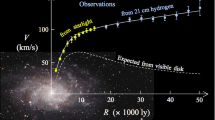Abstract
It was recently discovered that the mean dark matter surface density within one dark halo scale-length (the radius within which the volume density profile of dark matter remains approximately flat) is constant across a wide range of galaxies1. This scaling relation holds for galaxies spanning a luminosity range of 14 magnitudes and the whole Hubble sequence1,2,3. Here we report that the luminous matter surface density is also constant within one scale-length of the dark halo. This means that the gravitational acceleration generated by the luminous component in galaxies is always the same at this radius. Although the total luminous-to-dark matter ratio is not constant, within one halo scale-length it is constant. Our finding can be interpreted as a close correlation between the enclosed surface densities of luminous and dark matter in galaxies4.

Similar content being viewed by others
References
Donato, F. et al. A constant dark matter halo surface density in galaxies. Mon. Not. R. Astron. Soc. 397, 1169–1176 (2009)
Kormendy, J. & Freeman, K. C. Scaling laws for dark matter halos in late-type and dwarf spheroidal galaxies. IAU Symp. Astron. Soc. Pacif. 220, 377–395 (2004)
Spano, M. et al. GHASP: an Hα kinematic survey of spiral and irregular galaxies—V. Dark matter distribution in 36 nearby spiral galaxies. Mon. Not. R. Astron. Soc. 383, 297–316 (2008)
McGaugh, S. S. The mass discrepancy-acceleration relation: disk mass and the dark matter distribution. Astrophys. J. 609, 652–666 (2004)
Burkert, A. The structure of dark matter halos in dwarf galaxies. Astrophys. J. 447, L25–L28 (1995)
McGaugh, S. S. Balance of dark and luminous mass in rotating galaxies. Phys. Rev. Lett. 95, 171302 (2005)
Milgrom, M. A modification of the Newtonian dynamics as a possible alternative to the hidden mass hypothesis. Astrophys. J. 270, 365–370 (1983)
Famaey, B., Gentile, G., Bruneton, J.-P. & Zhao, H. S. Insight into the baryon-gravity relation in galaxies. Phys. Rev. D 75, 063002 (2007)
Persic, M., Salucci, P. & Stel, F. The universal rotation curve of spiral galaxies—I. The dark matter connection. Mon. Not. R. Astron. Soc. 281, 27–47 (1996)
Gentile, G. MOND and the universal rotation curve: similar phenomenologies. Astrophys. J. 684, 1018–1025 (2008)
Yegorova, I. A. & Salucci, P. The radial Tully-Fisher relation for spiral galaxies—I. Mon. Not. R. Astron. Soc. 377, 507–515 (2007)
Zwaan, M. A. et al. The Tully-Fisher relation for low surface brightness galaxies: implications for galaxy evolution. Mon. Not. R. Astron. Soc. 273, L35–L38 (1995)
Milgrom, M. & Sanders, R. H. MOND predictions of halo phenomenology in disc galaxies. Mon. Not. R. Astron. Soc. 357, 45–48 (2005)
Gentile, G., Salucci, P., Klein, U. & Granato, G. L. NGC 3741: the dark halo profile from the most extended rotation curve. Mon. Not. R. Astron. Soc. 375, 199–212 (2007)
Gentile, G., Burkert, A., Salucci, P., Klein, U. & Walter, F. The dwarf galaxy DDO 47 as a dark matter laboratory: testing cusps hiding in triaxial halos. Astrophys. J. 634, L145–L148 (2005)
de Blok, W. J. G. et al. High-resolution rotation curves and galaxy mass models from THINGS. Astron. J. 136, 2648–2719 (2008)
Acknowledgements
G.G. was supported by the FWO-Vlaanderen (Belgium), and B.F. was supported in part by the Alexander von Humboldt foundation (Germany), the FNRS (Belgium), and the CNRS (France). We thank A. Jorissen and L. Hill for their comments on the manuscript.
Author Contributions G.G. and B.F. contributed to analysing and interpreting the data, making the figures, and writing the paper. HS.Z. and P.S. contributed to interpreting the data.
Author information
Authors and Affiliations
Corresponding author
Supplementary information
Supplementary Information
This file contains Supplementary Notes and Data, Supplementary References, Supplementary Table 1and Supplementary Figures 1-3 with References. (PDF 198 kb)
PowerPoint slides
Rights and permissions
About this article
Cite this article
Gentile, G., Famaey, B., Zhao, H. et al. Universality of galactic surface densities within one dark halo scale-length. Nature 461, 627–628 (2009). https://doi.org/10.1038/nature08437
Received:
Accepted:
Issue Date:
DOI: https://doi.org/10.1038/nature08437
- Springer Nature Limited
This article is cited by
-
A universal constant for dark matter-baryon interplay
Scientific Reports (2019)
-
Can decaying sterile neutrinos account for all dark matter?
Astrophysics and Space Science (2016)
-
Cold dark matter heats up
Nature (2014)
-
Recent developments in dark matter searches
Pramana (2011)





